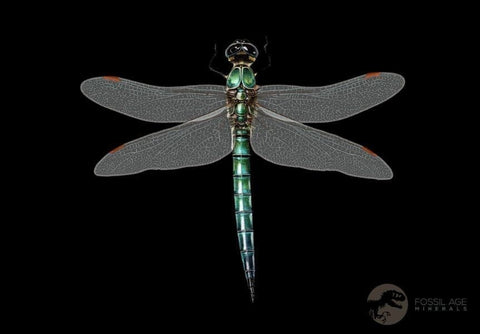0.7" Dragonfly Larvae Fossil Libellula Doris Plate Upper Miocene Piemont Italy Display
Location: Piemonte Area, Santa Vittoria d’Alba. Italy
Weight: 1.8 Ounces With Display.
Dimensions: 3.3 Inches Long, 2.5 Inches Wide, 1 Inch Thick (Display)
Dimensions: 2.2 Inches Long, 1.8 Inches Wide, 0.2 Inches Thick (Plate)
Insect Dimensions: 0.7 Inches Long, 0.6 Inches Wide
Comes with a Free White Display Box.
Comes with a Certificate of Authenticity.
The item pictured is the one you will receive.
Upper Miocene, 16 Million-Year-old
Fossil Dragonfly Larvae, Libellula Doris
This exquisite fossil plate was acquired from a dealer who has exclusive access to a unique shale outcrop located in the foothills of the Alps, where such specimens are carefully quarried. The thin shale slab displays three complete dragonfly fossils, beautifully arranged in a naturally aesthetic composition. The preservation is exceptional, showing fine anatomical details with striking visual appeal.
Libellula is a genus of modern dragonflies, commonly known as skimmers. Members of this genus are often brightly colored and may feature distinctive wing banding. Dragonflies belong to the order Odonata and the family Libellulidae, distinguished by a hindwing that is broader than the forewing. They are characterized by large, multifaceted eyes, two pairs of strong, transparent wings, and elongated bodies.
Although often mistaken for damselflies, dragonflies can be identified by the position of their wings, which are typically held perpendicular to the body when at rest. Like all insects, they have six legs, though they are not adept at walking. Notably, dragonflies are among the fastest-flying insects on Earth.
As skilled aerial predators, dragonflies feed on mosquitoes and other small insects such as flies, bees, ants, and wasps. They are commonly found near wetlands, lakes, streams, and ponds, as their aquatic larvae—known as “nymphs”—depend on such habitats. Today, over 5,680 species of dragonflies (order Odonata) are known worldwide.
Female dragonflies lay eggs in or near water, often on floating or emergent plants. When laying eggs, some species will submerge themselves completely to lay their eggs on a suitable surface. The eggs then hatch into naiads. Most of a dragonfly's life is spent in the naiad form, beneath the water's surface, using extendable jaws to catch other invertebrates (often mosquito larvae) or even vertebrates such as tadpoles and fish. They breathe through gills in their rectum, and can rapidly propel themselves by suddenly expelling water through the anus. Some naiads even hunt on land, an aptitude that could have been more common in ancient times, when terrestrial predators were less agile.
The larval stage of large dragonflies may last as long as five years. In smaller species, this stage may last between two months and three years. When the naiad is ready to metamorphose into an adult, it climbs up a reed or other emergent plant. Exposure to air causes the naiad to begin breathing. The skin splits at a weak spot behind the head, and the adult dragonfly crawls out of its larval skin, pumps up its wings, and flies off to feed on midges and flies. In flight, the adult dragonfly can propel itself in six directions: upward, downward, forward, backward, and side to side. The adult stage of larger species of dragonflies can last as long as five or six months.


















